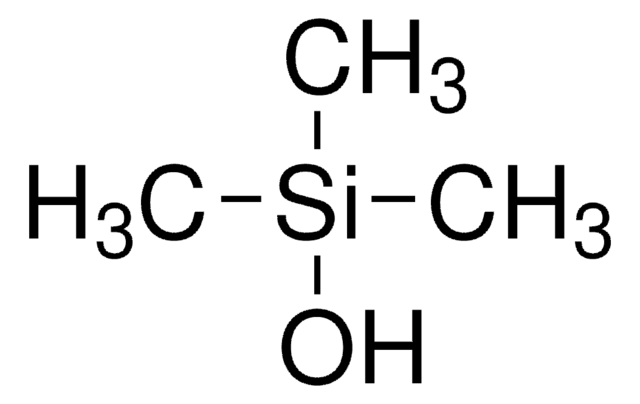All Photos(1)
About This Item
Linear Formula:
Si(CH3)4
CAS Number:
Molecular Weight:
88.22
Beilstein:
1696908
EC Number:
MDL number:
UNSPSC Code:
12352103
PubChem Substance ID:
NACRES:
NA.22
Recommended Products
vapor pressure
11.66 psi ( 20 °C)
Assay
≥99.0% (GC)
form
liquid
autoignition temp.
842 °F
refractive index
n20/D 1.358 (lit.)
n20/D 1.359
bp
26-28 °C (lit.)
mp
−99 °C (lit.)
density
0.648 g/mL at 25 °C (lit.)
storage temp.
2-8°C
SMILES string
C[Si](C)(C)C
InChI
1S/C4H12Si/c1-5(2,3)4/h1-4H3
InChI key
CZDYPVPMEAXLPK-UHFFFAOYSA-N
Looking for similar products? Visit Product Comparison Guide
Related Categories
Application
Tetramethylsilane can be used as a silicon precursor for the synthesis of silicon doped diamond-like carbon (DLC-Si) films and silicon carbide (SiC) bulk crystals. It can also be used as a hydrocarbon substrate to study intermolecular C-H activation chemistry.
Signal Word
Danger
Hazard Statements
Precautionary Statements
Hazard Classifications
Flam. Liq. 1
Storage Class Code
3 - Flammable liquids
WGK
WGK 3
Flash Point(F)
-16.6 °F - closed cup
Flash Point(C)
-27 °C - closed cup
Personal Protective Equipment
dust mask type N95 (US), Eyeshields, Gloves
Choose from one of the most recent versions:
Already Own This Product?
Find documentation for the products that you have recently purchased in the Document Library.
Customers Also Viewed
Intermolecular C- H Activation of Hydrocarbons by Tungsten Alkylidene Complexes: An Experimental and Computational Mechanistic Study.
Adams CS, et al.
Organometallics, 20(23), 4939-4955 (2001)
The mechanical and biocompatibility properties of DLC-Si films prepared by pulsed DC plasma activated chemical vapor deposition.
Bendavid A, et al.
Diamond and Related Materials, 16(8), 1616-1622 (2007)
High-temperature chemical vapor deposition for SiC single crystal bulk growth using tetramethylsilane as a precursor.
Nam DH, et al.
Crystal Growth & Design, 14(11), 5569-5574 (2014)
The effects of Si incorporation on the electrochemical and nanomechanical properties of DLC thin films.
Papakonstantinou P, et al.
Diamond and Related Materials, 11(3-6), 1074-1080 (2002)
Roy E Hoffman
Journal of magnetic resonance (San Diego, Calif. : 1997), 163(2), 325-331 (2003-08-14)
The chemical shift of TMS is commonly assumed to be zero. However, it varies by over 1 ppm for 1H and 4 ppm for 13C and shows a correlation with the physical properties of the solvent. Using the commonly accepted
Our team of scientists has experience in all areas of research including Life Science, Material Science, Chemical Synthesis, Chromatography, Analytical and many others.
Contact Technical Service









